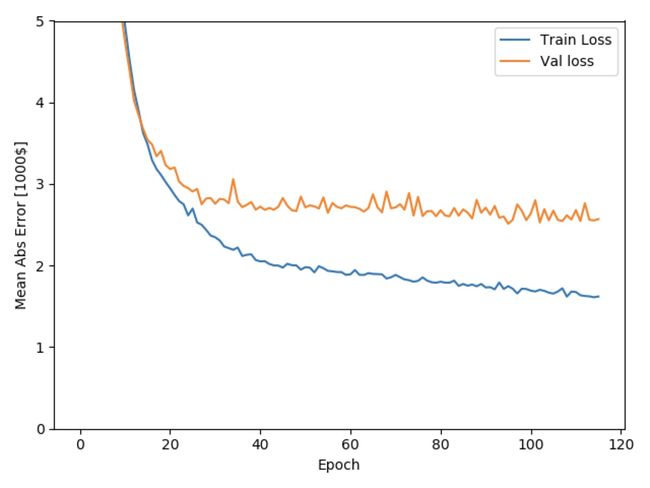前言
本教程来自TensorFlow官方教程 tensorflow.org,网站和大部分学习资源被墙,请自主进行科学上网。文章旨在记录自己学习机器学习相关知识的过程,如对您学习过程有所助益,不胜荣幸。文章是个人翻译,水平有限,希望理解。教程采用Anaconda版本的Python,是Python3代码,编辑器是Pycharm。
原文Github地址
原文colab地址(科学上网)
相比于判断图片是橘子还是苹果的分类问题,在一个回归问题中,我们的目标是预测一个连续的输出值,就像价格或者概率。
本次的教程将会建立一个模型来预测19世纪70年代中期波士顿郊区的房价。我们会提供给模型一些其他信息,例如犯罪率和当地的房地产税率。
在这个例子中我们会像之前那样使用keras库。你可以使用下面的代码来导入它:
import tensorflow as tf
from tensorflow import keras
import numpy as np
print(tf.__version__)
1.10.0
波士顿房价数据集
这个数据集现在也可以通过TensorFlow的代码可以直接获取。你可以使用下面代码来获取:
boston_housing = keras.datasets.boston_housing
(train_data, train_labels), (test_data, test_labels) = boston_housing.load_data()
# Shuffle the training set
order = np.argsort(np.random.random(train_labels.shape))
train_data = train_data[order]
train_labels = train_labels[order]
Downloading data from https://storage.googleapis.com/tensorflow/tf-keras-datasets/boston_housing.npz
57344/57026 [==============================] - 0s 0us/step
样例和特点
这次的数据集相比之前小了不少:它仅有506个,并且404个用来训练,拿出102个用来当作测试数据集。
print("Training set: {}".format(train_data.shape)) # 404 examples, 13 features
print("Testing set: {}".format(test_data.shape)) # 102 examples, 13 features
Training set: (404, 13)
Testing set: (102, 13)
这个数据集包含了13个不同的特征属性:
- 人均犯罪率
- 占地面积超过25,000平方英尺的住宅用地比例。
- 每个城镇非零售业务的比例。
- 查尔斯河虚拟变量 如果是大片土地则为1,否则为0
- 氮的氧化物浓度(分之1000万
- 平均每人所住房间数
- 1940年前业主单位所占的比例
- 到达波士顿就业中心的加权距离
- 到达径向公路的系数
- 所有财产价值的每10000美元的税率
- 城镇师生比例
- 城镇黑人比例按照式计算
- 地位较低人士的百分比
每一个输入数据的特征都以不同的大小存储着。有些特征值是0和1之间的浮点数,代表着百分比。有些可能是1到12之间的整数,有些则是0到100之间的整数。这些都是现实世界中数据的真实存在形式,理解并学会对这些数据的清理是一项重要的开发技能。
print(train_data[0]) # Display sample features, notice the different scales
[7.8750e-02 4.5000e+01 3.4400e+00 0.0000e+00 4.3700e-01 6.7820e+00
4.1100e+01 3.7886e+00 5.0000e+00 3.9800e+02 1.5200e+01 3.9387e+02
6.6800e+00]
我们可以使用pandas库的图表来更好的展示训练集中的几组数据:
import pandas as pd
column_names = ['CRIM', 'ZN', 'INDUS', 'CHAS', 'NOX', 'RM', 'AGE', 'DIS', 'RAD',
'TAX', 'PTRATIO', 'B', 'LSTAT']
df = pd.DataFrame(train_data, columns=column_names)
print(df.head())
CRIM ZN INDUS CHAS NOX ... RAD TAX PTRATIO B LSTAT
0 0.07875 45.0 3.44 0.0 0.437 ... 5.0 398.0 15.2 393.87 6.68
1 4.55587 0.0 18.10 0.0 0.718 ... 24.0 666.0 20.2 354.70 7.12
2 0.09604 40.0 6.41 0.0 0.447 ... 4.0 254.0 17.6 396.90 2.98
3 0.01870 85.0 4.15 0.0 0.429 ... 4.0 351.0 17.9 392.43 6.36
4 0.52693 0.0 6.20 0.0 0.504 ... 8.0 307.0 17.4 382.00 4.63
标签
标签值就是以千美金为单位的房价
print(train_labels[0:10]) # Display first 10 entries
[32. 27.5 32. 23.1 50. 20.6 22.6 36.2 21.8 19.5]
标准化数据
建议对使用不同比例和范围的特征值进行标准化。对于每个特征值,减去特征值的平均值并除以标准偏差:
# Test data is *not* used when calculating the mean and std.
mean = train_data.mean(axis=0)
std = train_data.std(axis=0)
train_data = (train_data - mean) / std
test_data = (test_data - mean) / std
print(train_data[0]) # First training sample, normalized
[-0.39725269 1.41205707 -1.12664623 -0.25683275 -1.027385 0.72635358
-1.00016413 0.02383449 -0.51114231 -0.04753316 -1.49067405 0.41584124
-0.83648691]
尽管数据没有经过标准化时依然可以进行训练,但是这样会使训练难度提升,并且会导致模型过于依赖输入神经元。
创建模型
def build_model():
model = keras.Sequential([
keras.layers.Dense(64, activation=tf.nn.relu,
input_shape=(train_data.shape[1],)),
keras.layers.Dense(64, activation=tf.nn.relu),
keras.layers.Dense(1)
])
optimizer = tf.train.RMSPropOptimizer(0.001)
model.compile(loss='mse',
optimizer=optimizer,
metrics=['mae'])
return model
model = build_model()
model.summary()
这次的模型采用的都是全连接层。输出层是一个连续的函数值。
_________________________________________________________________
Layer (type) Output Shape Param #
=================================================================
dense (Dense) (None, 64) 896
_________________________________________________________________
dense_1 (Dense) (None, 64) 4160
_________________________________________________________________
dense_2 (Dense) (None, 1) 65
=================================================================
Total params: 5,121
Trainable params: 5,121
Non-trainable params: 0
_________________________________________________________________
训练模型
这次我们训练了500个epoch,并且把训练记录放在了history对象中:
# Display training progress by printing a single dot for each completed epoch.
class PrintDot(keras.callbacks.Callback):
def on_epoch_end(self,epoch,logs):
if epoch % 100 == 0: print('')
print('.', end='')
EPOCHS = 500
# Store training stats
history = model.fit(train_data, train_labels, epochs=EPOCHS,
validation_split=0.2, verbose=0,
callbacks=[PrintDot()])
....................................................................................................
....................................................................................................
....................................................................................................
....................................................................................................
....................................................................................................
训练过程的数据都保存在了history里面,我们可以通过画图来查看训练过程:
import matplotlib.pyplot as plt
def plot_history(history):
plt.figure()
plt.xlabel('Epoch')
plt.ylabel('Mean Abs Error [1000$]')
plt.plot(history.epoch, np.array(history.history['mean_absolute_error']),
label='Train Loss')
plt.plot(history.epoch, np.array(history.history['val_mean_absolute_error']),
label = 'Val loss')
plt.legend()
plt.ylim([0,5])
plot_history(history)
从图中可以看出,在200个epoch之后模型的提升率就很小了。我们可以通过更新一下模型的训练方式让模型在提升较小的时候停止训练。我们可以设置下面的回调函数来让模型自动停止训练:
model = build_model()
# The patience parameter is the amount of epochs to check for improvement.
early_stop = keras.callbacks.EarlyStopping(monitor='val_loss', patience=20)
history = model.fit(train_data, train_labels, epochs=EPOCHS,
validation_split=0.2, verbose=0,
callbacks=[early_stop, PrintDot()])
plot_history(history)
....................................................................................................
................
训练好像确实提前终止了
图中显示平均误差值大概在
让我们看看我们的模型在测试数据上的表现如何:
[loss, mae] = model.evaluate(test_data, test_labels, verbose=0)
print("Testing set Mean Abs Error: ${:7.2f}".format(mae * 1000))
Testing set Mean Abs Error: $2679.54
预测
test_predictions = model.predict(test_data).flatten()
print(test_predictions)
[ 7.832362 18.450851 22.45164 34.88103 27.348196 22.26736
26.963049 21.669811 19.895964 22.601202 19.965273 17.110151
16.567072 44.0524 21.04799 21.103464 26.45786 18.709482
20.825438 27.020702 11.160862 13.017411 22.807884 16.611425
21.076998 26.213572 32.766167 32.652153 11.298579 20.164223
19.82201 14.905633 34.83156 24.764723 19.957857 8.5664625
16.906912 17.79298 18.071428 26.850712 32.625023 29.406805
14.310859 44.013615 31.179125 28.41265 28.72704 19.22457
23.301258 23.555346 37.15091 19.271719 10.640091 14.898285
36.21053 29.63736 12.255004 50.43345 37.141464 26.562092
25.075682 15.84047 15.081948 20.062723 25.168509 21.119642
14.220254 22.637339 12.629622 7.517413 25.981508 30.909727
26.12176 12.866787 25.869745 18.303373 19.470121 24.58047
36.444992 10.777396 22.28932 37.976543 16.47492 14.191712
18.707952 19.026419 21.038057 20.713434 21.794077 32.14987
22.412184 20.55821 27.877415 44.4067 38.00193 21.748753
35.57821 45.50506 26.612532 48.747063 34.60436 20.451048 ]
结论
这篇笔记介绍了一种解决回归问题的技巧:
- 均方误差(MSE)是一种适用于回归问题常见的损失函数。
- 在评估精度的时候回归问题是和分类问题不同的。在回归问题中我们使用了平均绝对误差(MAE)
- 当我们的输入数据的特征值在不同的范围内的时候,每一个特征值的大小都应该单独的进行缩放。
- 如果训练数据并不是太多,最好是选择比较小并且隐藏层比较少的神经网络模型来避免过度拟合
- 提前停止优化是一个比较有用的技巧来避免过度拟合。
#title MIT License
#
# Copyright (c) 2017 François Chollet
#
# Permission is hereby granted, free of charge, to any person obtaining a
# copy of this software and associated documentation files (the "Software"),
# to deal in the Software without restriction, including without limitation
# the rights to use, copy, modify, merge, publish, distribute, sublicense,
# and/or sell copies of the Software, and to permit persons to whom the
# Software is furnished to do so, subject to the following conditions:
#
# The above copyright notice and this permission notice shall be included in
# all copies or substantial portions of the Software.
#
# THE SOFTWARE IS PROVIDED "AS IS", WITHOUT WARRANTY OF ANY KIND, EXPRESS OR
# IMPLIED, INCLUDING BUT NOT LIMITED TO THE WARRANTIES OF MERCHANTABILITY,
# FITNESS FOR A PARTICULAR PURPOSE AND NONINFRINGEMENT. IN NO EVENT SHALL
# THE AUTHORS OR COPYRIGHT HOLDERS BE LIABLE FOR ANY CLAIM, DAMAGES OR OTHER
# LIABILITY, WHETHER IN AN ACTION OF CONTRACT, TORT OR OTHERWISE, ARISING
# FROM, OUT OF OR IN CONNECTION WITH THE SOFTWARE OR THE USE OR OTHER
# DEALINGS IN THE SOFTWARE.

